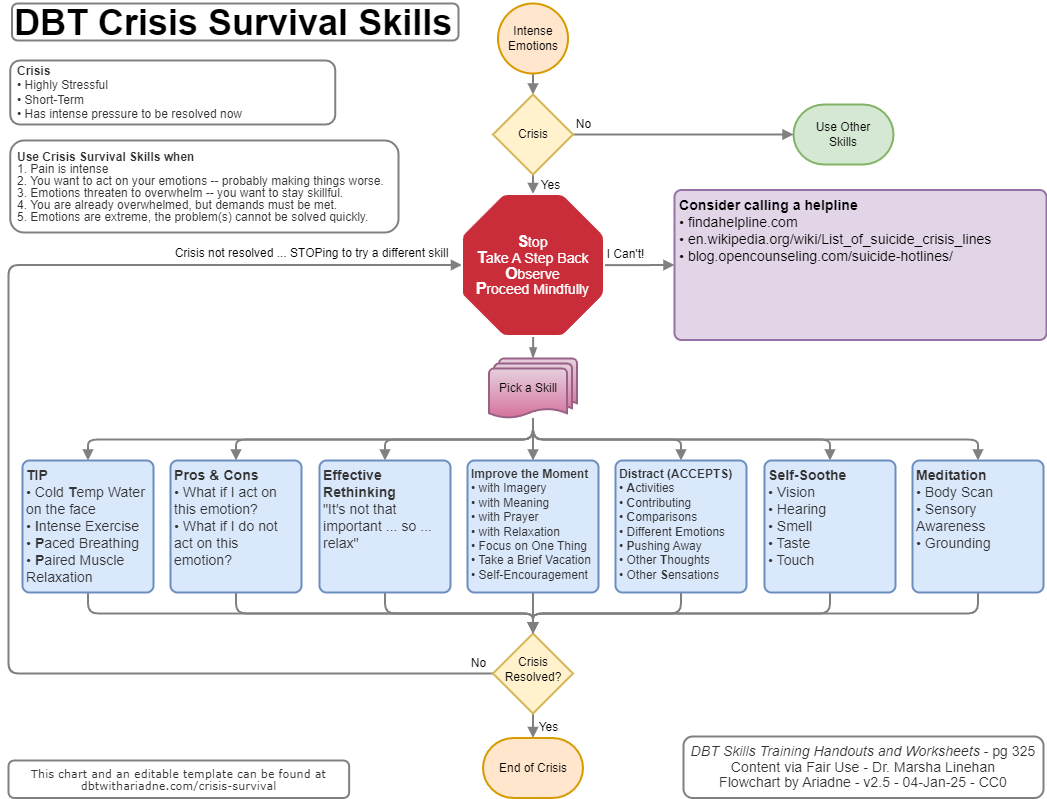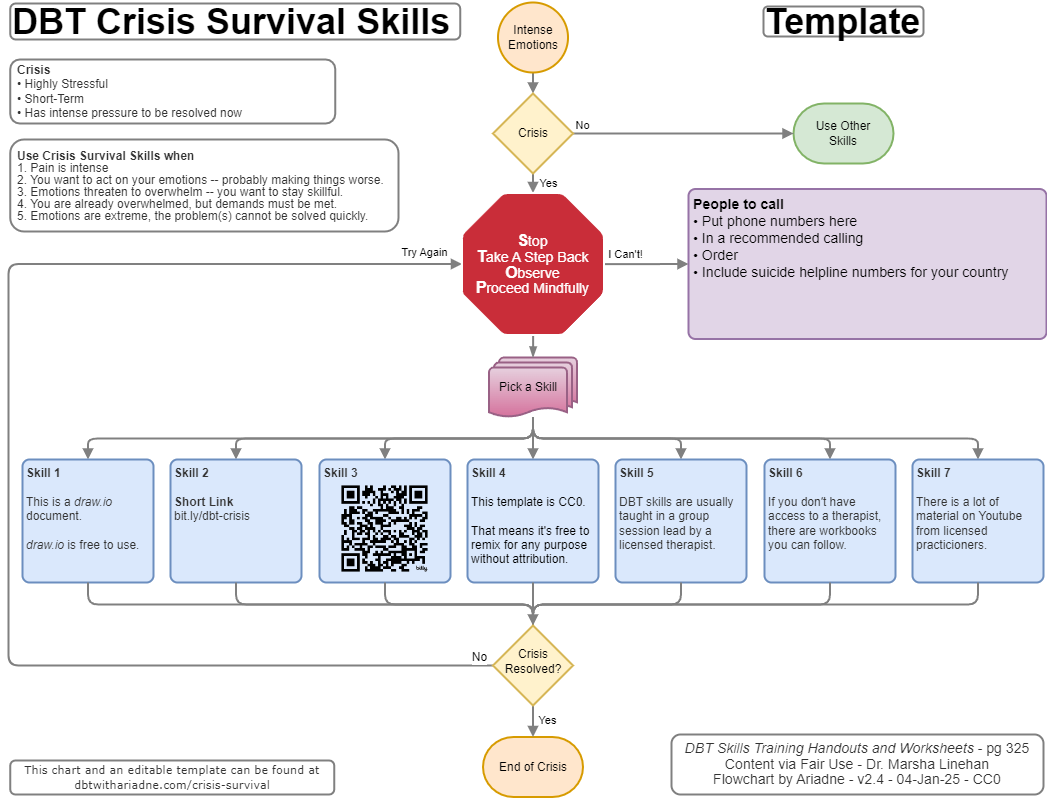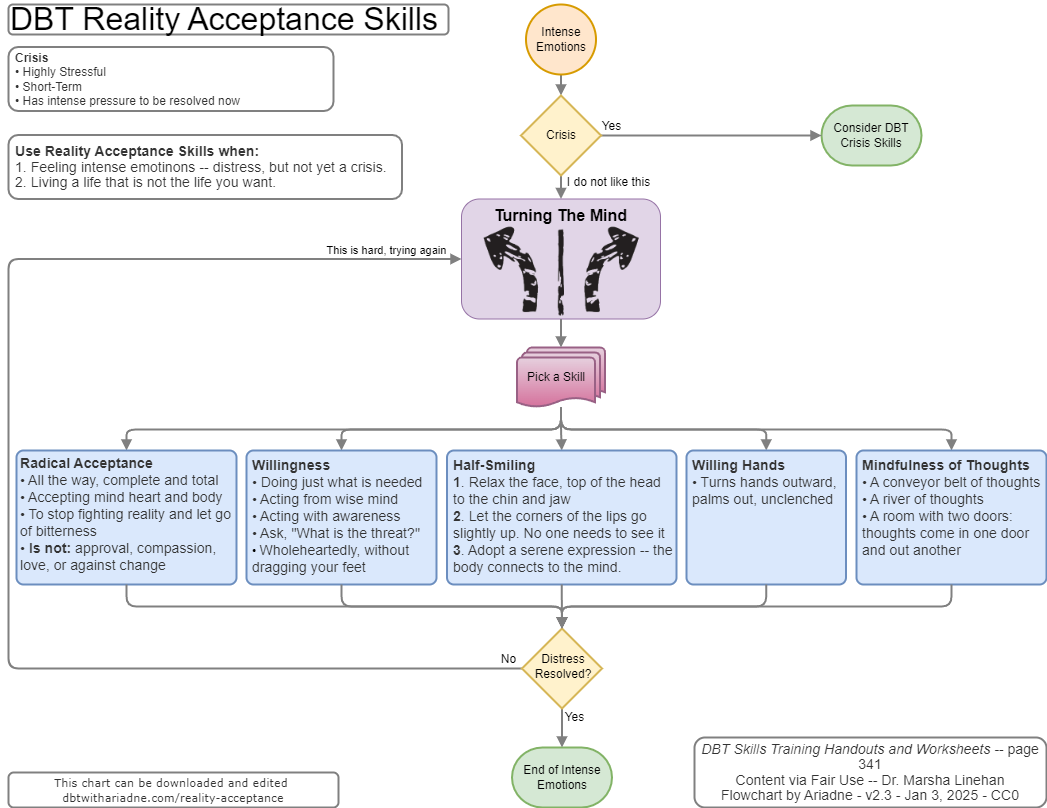DBT Crisis Survival Skills
These are DBT Crisis Survival and Distress Tolerance flowcharts. They use the skills from Marsha Linehan's book.
These charts are meant to serve as a printable reminder to use skills vs making the crisis worse.
Generic Chart
This is a generic chart, it's not always helpful.

Download this chart, then edit via draw.io.
Template
This is the template. Try different things -- write down what works to help future-you in crisis.

Download this chart, then edit via draw.io.
References
DBT Skills Training Manual, 2nd Ed. Marsha M. Linehan (2015) New York
Distress Tolerance Handout 10 pg. 341
v2.3 - Last edit 28-Jan-2025
This work dedicated to the Public Domain via CC0 1.0
DBT - Guidelines for Objectives Effectiveness: Getting What You Want
DBT Skills Training Manual, 2nd Ed. Marsha M. Linehan (2015) New York
Interpersonal Effectiveness Handout 5 pg. 145
Describe the situation.
Express your feelings.
Assert by asking or saying no.
Reinforce by describing a positive outcome.
Mindfully stay on the goal.
Appear confident.
Negotiate.
Describe
Calmly describe the situation using objective facts. Do not place blame. Stay on topic.
"Spend less time on your phone!"
"Why are you on your phone all the time?"
"I see you are on your phone."
"You need to do the dishes!"
"When are you going to do the dishes?"
"I noticed the dishes haven't been done yet."
Express
Feelings and opinions. Keep statements about how you feel.
"You are so easily distracted"
"You ignore me all the time!"
"I feel lonely when you spend so much time on your phone."
"You always make me beg you do to the dishes."
"I'm frustrated the dishes haven't been done."
Assert
Ask for what you want. Say no clearly. Others cannot read your mind.
"Please spend some time with me."
"We've agreed that each of us does the dishes, every other meal.
Reinforce
Explain a positive outcome that happens if you get what you want.
"We can play a game together.
"When the dishes are done, we'll both feel better.
Mindfully
Focus on your goal. Don't get distracted.
Appear Confident
Use a confident tone of voice, make eye contact, an assertive posture.
Negotiate
Give to get, reduce the request, say no, but offer to do something else, focus on what would work.
v2.3 - Last edit 4-Jan-2025
DBT - Ending Relationships - Interpersonal Effectiveness Handout 13
DBT Skills Training Manual, 2nd Ed. Marsha M. Linehan (2015) New York
Interpersonal Effectiveness Handout 13 pg. 145
Are you in crisis or distress?
These guidelines also work for groups. "Should I stay in this group?"
I've added some of my notes as footnotes, since I struggle to understand what Marsha means with some of these words.
Decide to end relationships in WISE MIND, never in emotion mind.
Destructive Relationships
Destroy or completely spoil these personal qualities
- The relationship itself1
- Your enjoyment of your body2
- Felt safety, especially emotional3
- Self-Compassion4 & Self-Image5
- Self-Respect & Integrity6
- Happiness7
- Peace of Mind8
- Your ability to care for the other person9
Healthy relating is: give and take, both sides practicing forgiveness, validation, change, and acceptance.
This includes: physical abuse, sexual abuse, having space to yourself, a safe place to sleep, and food to eat.
This includes emotional abuse such as: negation, projection, gaslighting, invalidation, name calling, and financial abuse.
One of the goals of DBT is to arrive at a "A life worth living." Not enduring, or putting up with stuff. The goal is to enjoy this. Part of self-esteem and self-integrity is self-respect. Starting to understand who you are (or at least who you want to be), working towards that, and having people in your life who can support you. Anyone reading this has probably endured enough.
There are partners who will love you for who you are, not who they want you to be. Part of this journey is also giving yourself compassion. Someone who takes away your ability to like yourself is destructive.
This includes your hobbies, choice of career, friends, and lifestyle.
Happiness as a felt experience in the body. The kind you might get walking in nature, being with a friend or family member, or doing something you enjoy.
This is related to attachment theory. Hopefully the person you are caring for is open to you trying to care for them -- this includes their willingness to get help, treatment, and therapy.
You have a right to a relationship without drama, where you can sleep at night, have reasonable expectations what they might do.
Interfering Relationships
Interfere with these parts of your life
If a relationship is important and interfering, you can try Problem Solving to repair it.
It's OK to have your own goals. It's hard to acknowledge that a goal you want may not be a goal someone else wants for you. If this conflict is strong enough, the relationship should be ended.
You are allowed to exist and take up space. You don't need to save everyone. You can have hobbies, and be idle. You can smell the flowers, but you need to give yourself the space to do that. Co-dependency goes here.
You are allowed to have things you enjoy, even if others aren't interested. Your hobbies and interests can be as random and niche as you'd like. What would you like doing?
You are allowed your own friends.
As found family becomes more common, it's important to find people who are also OK with your found family and friends.
-
Decide to end relationships in Wise Mind, never in emotion mind.
-
If the relationship is important and not destructive, and there is reason to hope it can be improved, try Problem Solving to repair a difficult relationship.
-
Cope Ahead to troubleshoot and practice ending the relationship ahead of time.
-
Be direct: Use the DEAR MAN, GIVE, and FAST interpersonal effectiveness skills.
-
Practice opposite action for love when you find you love the wrong person.
-
Practice safety first! Before leaving a highly abusive or life-threatening relationship, call a local domestic violence hotline or the toll-free National Domestic Violence Hotline (1-800-799-7233) for help with safety planning and a referral to a qualified professional. See also the International Directory of Domestic Violence Agencies.
More Articles
What is Codependency - Very Well Mind Needs Inventory - Center for Nonviolent Communication
DBT - Sleep Hygiene Protocol - Emotion Regulation Handout 20
DBT Skills Training Manual, 2nd Ed. Marsha M. Linehan (2015) New York
Emotional Regulation Handout 20B pg. 259
When You Can’t Sleep, What to Do Instead of Ruminating
To Increase the Likelihood of Restfulness/Sleep
-
Develop and follow a consistent sleep schedule even on weekends. Go to bed and get up at the same times each day, and avoid anything longer than a 10-minute nap during the day.
-
Do not use your bed in the daytime for things like watching TV, talking on the phone, or reading.
-
Avoid caffeine, nicotine, alcohol, heavy meals, and exercise late in the day before going to sleep.
-
When prepared to sleep, turn off the light, and keep the room quiet and the temperature comfortable and relatively cool. Try an electric blanket if you are cold; putting your feet outside of the blanket or turning on a fan directed toward your bed if you are hot; or wearing a sleeping mask, using earplugs, or turning on a “white noise” machine if needed.
-
Give yourself half an hour to at most an hour to fall asleep. If it doesn’t work, evaluate whether you are calm, or anxious (even if only “background anxiety”), or ruminating.
-
Do not catastrophize. Remind yourself that you need rest, and aim for reverie (i.e., dreaminess) and resting your brain. Sell yourself on the idea that staying awake is not a catastrophe. Do not decide to give up on sleeping for the night and get up for the “day.”
If You Are Calm but Wide Awake
-
Get out of bed; go to another room and read a book or do some other activity that will not wake you up further. As you begin to get tired and/or sleepy, go back to bed.
-
Try a light snack (e.g., an apple).
If You Are Anxious or Ruminating
-
Use the cold water TIP skill. Get right back in bed and do the paced breathing TIP skill. (See Distress Tolerance Handout 6: TIP Skills: Changing Your Body Chemistry.) Remember, if you have any medical condition, get medical approval before using cold water.
-
Try the 9–0 meditation practice. Breathe in deeply and breathe out slowly, saying in your mind the number 9. On the next breath out, say 8; then say 7; and so on until you breathe out saying 0. Then start over, but this time start with 8 (instead of 9) as you breathe out, followed by 7, and so on until you reach 0. Next start with 6 as you breathe out, and so on to 0. Then start with 5, then with 4, and so on until you have gone all the way down to starting with 1. (If you get lost, start over with the last number you remember.) Continue until you fall asleep.
-
Focus on the bodily sensation of the rumination (rumination is often escape from difficult emotional sensations).
-
Reassure yourself that worries in the middle of the night are just “middle-of-the-night-thinking,” and that in the morning you will think and feel differently.
-
Read an emotionally engrossing novel for a few minutes until you feel somewhat tired. Then stop reading, close your eyes, and try to continue the novel in your head.
-
If rumination doesn’t stop, follow these guidelines: “If it’s solvable, solve it. If it is insolvable, go deep into the worry all the way to the “catastrophe”—the very worst outcome you can imagine—and then imagine coping ahead with the catastrophe. (See Emotion Regulation Handout 19: Build Mastery and Cope Ahead.)
If nothing else works, with eyes closed, listen to public radio (BBC, NPR , etc.) at low volume (use headphones if necessary). Public radio is a good choice for this, because there is little fluctuation in voice tone or volume.
v1.3 - Last edit 4-Jan-2025
DBT Reality Acceptance Skills
This is a DBT Reality Acceptance Skills flowchart. It uses the skills from Marsha Linehan's book.
The chart is meant to serve as a printable shorthand to help re-train behavior to ease day-to-day emotional turmoil.

DBT Reality Acceptance - draw.io
Download the file, then edit via draw.io.
References
DBT Skills Training Manual, 2nd Ed. Marsha M. Linehan (2015) New York
Distress Tolerance Handout 10 pg. 341
v2.2 - Last edit 4-Jan-2025
This work is dedicated to the Public Domain via CC0 1.0
cw: pain, abuse, trauma, dissociation, suicide, self-harm
I am familiar with dissociation. While dissociaton can be a useful coping strategy, it is disruptive, so I started to look for alternative ways to cope.
Forgetting things isn't glamorous. There is always the risk that if I don't write something down, I will forget it. This blog represents some of the brightest parts of myself I want to remember and share with others.
Without written record, my lived experience sometimes becomes moment-to-moment and some moments are unbearable. I'm in several overlapping groups for suicide risk. I want to survive those future moments of pain.
Some of the charts found on this blog, I have laminated in my house. They are my personal materials.
Other charts I have made to reference quickly for online peer-support.
In the spirit of giving this book isn't monetized. Most of the content contained is dedicated to the Public Domain via CC0 so it can be copied, remixed, and repurposed.
I hope nothing I've written in this book causes myself or others to come to harm.
Contact Me
Email: dbt with ariadne [at] gmail [dot] com
v2.6 - Last edit 21-Jan-2025
This is work dedicated to the Public Domain via CC0 1.0